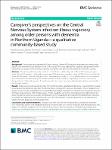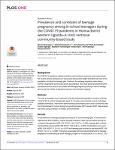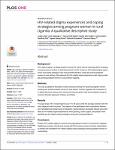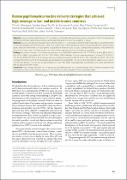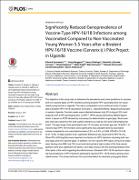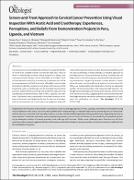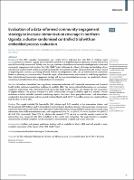Search
Now showing items 1-10 of 42
Caregiver’s perspectives on the Central Nervous System infection illness trajectory among older persons with dementia in Northern Uganda—a qualitative community‑based study
(BMC Geriatrics, 2022)
Background: Few studies have explored the Central Nervous System (CNS) infection illness trajectory among older
persons with dementia in sub-Saharan African (SSA) settings. This study explored the Caregiver’s perspectives ...
Prevalence and correlates of teenage pregnancy among in-school teenagers during the COVID-19 pandemic in Hoima district western Uganda–A cross sectional community-based study
(PLoS ONE, 2022)
Background
The COVID-19 pandemic related restrictions and lockdown measures had compromised
the routine delivery and access of sexual and reproductive health and rights services to the
population including the teenage ...
HIV-related stigma experiences and coping strategies among pregnant women in rural Uganda: A qualitative descriptive study
(PloS one, 2022)
Background
HIV-related stigma is a global problem among HIV clients with far-reaching effects including
increased rates of mother-to-child transmission of HIV. However, HIV-related stigma experiences
and coping strategies ...
Consumer Perspectives on a Pericoital Contraceptive Pill in India and Ugand
(2013)
CONTEXT: Studies suggest that women in some countries have adopted emergency contraceptive pills as a routine method of family planning. This practice indicates there may be latent demand for a pericoital contraceptive ...
Impacts of IRC’s Fifth Child community engagement strategy to increase immunisation in northern Uganda
(2019)
The 2011 Uganda Demographic and Health Survey (UDHS) reported that the national coverage of the third dose of the combined diphtheria, pertussis, tetanus vaccine (DPT3) among children 12-23 months of age was 73%, and only ...
Human papillomavirus vaccine delivery strategies that achieved high coverage in low- and middle-income countries
(Bull World Health Organ, 2011)
Objective
To assess human papillomavirus (HPV) vaccination coverage after demonstration projects conducted in India, Peru, Uganda and Viet Nam by PATH and national governments and to explore the reasons for vaccine ...
Significantly Reduced Genoprevalence of Vaccine-Type HPV-16/18 Infections among Vaccinated Compared to Non-Vaccinated Young Women 5.5 Years after a Bivalent HPV-16/18 Vaccine (Cervarix1) Pilot Project in Uganda
(2016)
The objective of this study was to determine the prevalence and some predictors for vaccine
and non-vaccine types of HPV infections among bivalent HPV vaccinated and non-vaccinated
young women in Uganda. This was a ...
Screen-and-Treat Approach to Cervical Cancer Prevention Using Visual Inspection With Acetic Acid and Cryotherapy: Experiences, Perceptions, and Beliefs From Demonstration Projects in Peru, Uganda, and Vietnam
(The oncologist, 2013)
Cervical cancer is preventable but continues to cause the deaths
of more than 270,000 women worldwide each year, most of
them in developing countries where programs to detect and
treat precancerous lesions are not ...
Feasibility of delivering HPV vaccine to girls aged 10 to 15 years in Uganda
(African health sciences, 2015)
Background: Cervical cancer is a leading cause of mortality among women in Uganda. The availability of the human papillomavirus
(HPV) vaccine presents an opportunity to prevent cervical cancer. The Government of Uganda ...
Evaluation of a data-informed community engagement strategy to increase immunisation coverage in northern Uganda: a cluster-randomised controlled trial with an embedded process evaluation
(The Lancet Global Health, 2018)
Background The 2016 Ugandan Demographic and Health Survey indicated that only 86% of children (aged
12–23 months) in northern Uganda had received the third dose of diphtheria-tetanus-pertussis vaccine (DTP3) and
only 65% ...

